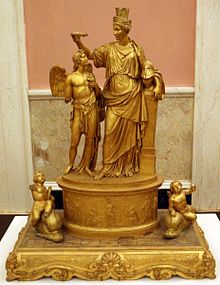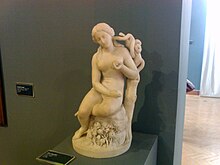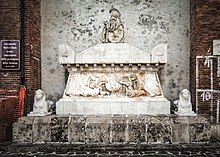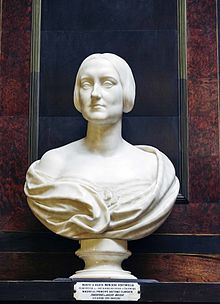Tito Angelini

Tito Angelini (born March 10, 1806 in Naples , † February 9, 1878 ibid) was an Italian sculptor who was mainly active in his hometown.


biography
Son of Costanzo Angelini , graduated from Rome . After enrolling at the Accademia di Belle Arti di Napoli, he suffered from the influences of the then trendy sculptors, whose artistic culture was shaped by people like Antonio Canova and the Dane Bertel Thorvaldsen .
He made numerous trips through Italy , during which he established relationships with numerous artists (including Pietro Tenerani , Luigi Pampaloni and Lorenzo Bartolini ), although his activity as a sculptor took place mainly in Naples, where he taught sculpture and was director of the Scuola di disegno .
The success he achieved in these courses led to his receiving numerous official commissions for works such as La Clemenza and L'Immacolata for the staircase and chapel of the Palazzo Reale in Naples.
Among his most important works are the tomb of Lucia Migliaccio and the tomb of Michele Arditi in the church of San Ferdinando , the monuments of Saverio Mercadante (in the square of the same name on Corso Vittorio Emanuele) and Paolo Emilio Imbriani (in Piazza Mazzini), the statue of St. Ambrose in the Church of San Francesco in Gaeta and the tomb of the mercenary leader Matteo Wade. There are also two busts commissioned by Prince Gaetano Filangieri , of Carlo Filangieri Duke of Taormina and his mother Agata Moncada di Paternò, which are in the Museo Civivo Gaetano Filangieri in Naples.
Further works by him can be found in the palace of Caserta : a series of six bas-reliefs in Alexander's hall, Philip the Macedonian entrusts Alexander to the young Aristotle, Alexander forces the Pythia to predict the future in Delphi and Alexander hands over his will before death; one of the two glorious winged soldiers with trophies as a relief in the throne room.
The sculptor Francesco Jerace built a slender and very elegant funerary monument for Tito Angelini in the Quadrilatero degli Uomini illustri (Square for Celebrities) of the Poggioreale Cemetery . It is right next to the one recently dedicated to the sculptor Augusto Perez, as a symbolic delivery of the best civil commemorative sculpture between the 19th and 20th centuries in Naples.
credentials
- ↑ guida alla reggia di caserta ed al parco -sala trono . Archived from the original on September 19, 2017. Retrieved July 10, 2019.
Web links
- Mario Pepe: Angelini, Tito. In: Alberto M. Ghisalberti (Ed.): Dizionario Biografico degli Italiani (DBI). Volume 3: Ammirato – Arcoleo. Istituto della Enciclopedia Italiana, Rome 1961.
| personal data | |
|---|---|
| SURNAME | Angelini, Tito |
| BRIEF DESCRIPTION | Italian sculptor |
| DATE OF BIRTH | March 10, 1806 |
| PLACE OF BIRTH | Naples |
| DATE OF DEATH | February 9, 1878 |
| Place of death | Naples |

